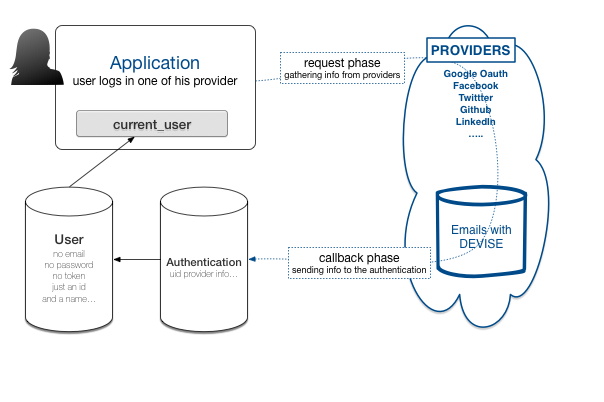This is a follow-up to the previous article I wrote about mixing concerns of Identity and Authentication. I encourage you to read it, however I’ll attempt to put it in a nutshell :
The User Model’s fundamental purpose is to give scope and integrity to various parts of the data in an application based on user interaction and ownership. Authentication on the other hand is the process which attempts to tie the user_id you provide to some person you claim to be. Yet all popular authentication gems (Devise, Sorcery, Authlogic…) mix both.
A strong clue for this separation of concern is authentication’s only done once (when you signin) while data integrity is ensured the rest of the time (current_user.orders etc.)
Based on that finding my proposal was to consider the usual email authentication process as just another Omniauth provider and have a separate User table to scope data & interactions.
From Omniauth-Identity to Omniauth-Devise
Omniauth-Identity was actually meant to to be used that way but nowhere in the various tutorials or implementations did I see the idea taken all the way down to its conclusion. So I thought lets go for it and make a proof of concept.
One minor detail annoyed me though, the impossibility of using nested params to send email and the password. I like my tools (SimpleForm, Form Objects, etc.) and being forced to write form_tag with none of the niceties I get with simple_form_for led me to want to create my own strategy for omniauth.
So I looked at the omniauth-identity gem to see how it worked. There was some cruft in it (form builder, many options..), but the crux of it all actually lied in one line :
module Omniauth::Strategies
def request_phase
::Identity.authenticate(conditions, request['password'] ) or fail!(:invalid)
super
end
end
At that point a small light bulb popped out of my brain : hey wait!… Why wouldn’t I use Devise for that. After all it has all the bells and whistles, why reinvent the wheel…
And the immediate after thought was the realization of Devise’s Original Sin :
instead of Devise using Omniauth with omniauthable it should’ve been the other way round from the very beginning, that is _Omniauth using Devise_ - as another provider. Devise’s Omniauthable module is like putting the bottle (omniauth) inside the water (devise).
NO Omniauth is the container ! and Devise’s the kool-aid.
Here’s a little diagram to illustrate the principle:

The Proof of Concept
So what does Omniauth-Devise look like ? It’s almost identical to omniauth-identity.
module OmniAuth
module Strategies
class Devise
include OmniAuth::Strategy
def callback_phase
return fail!(:invalid_credentials) unless devise_model
super
end
# some more stuff.....
def devise_model
resource = model.
find_for_database_authentication(request["session"].slice("email"))
resource if resource.valid_password?(request["session"]["password"])
end
end
end
end
Here’s what happens.
- You register your email and password in a model created by devise.
I called mine EmailId which is a terrible name please don’t do it !!!! bin/rails g devise email_id… I know yuck! But I wanted to make clear this is not our beloved User !!! You may then go through the process of confirming your email or not this is basic devise stuff.- Now the big difference (drumm rolllll) is you DO NOT LOGIN with DEVISE NOMORE !
Instead you point your login form to:
= simple_form_for UserSession.new, url: "/auth/devise/callback" do |f|
which points to
get "/auth/devise/callback", to: "session#create"
class SessionsController < ApplicationController
def create
auth = AuthenticateUser.build( env["omniauth.auth"] )
if auth.save
session[:user_id] = auth.user.id
redirect_to "/secret",
notice: "yeyy got there with omniauth and #{params[:provider]} as provider !"
else
render text: "failed sorry try again"
end
end
def destroy
session[:user_id] = nil
redirect_to root_path, notice: "You got outa omni box"
end
end
Now all we nedd is some secret sauce which ties Authentication and User together.
You’re all grown up developpers, I think it’ll be clear enough if you read it yourself :
class AuthenticateUser
include Virtus.model
include ActiveModel::Model
attribute :provider
attribute :uid
attribute :info, Hash
attribute :credentials, Hash
validates :provider, :uid, :info, presence: true
# instantiate AuthenticateUser with controller.env["omniauth.auth"]
def self.build( omni_hash )
self.new omni_hash.slice("provider", "uid", "info", "credentials")
end
def email
info.fetch("email")
end
def save
link_or_create_user
authentication.save
end
def authentication
@authentication ||= Authentication.
where(attributes.slice(:provider, :uid)).first_or_initialize
end
def user
@user ||= User.where(email: email).first_or_initialize
end
private
def link_or_create_user
authentication.user || authentication.user = user
end
end
Remember all this is just a proof of concept. I haven’t tested nor worked on many quirks. But believe me it works !
You don’t ???
Try it out for yourself the code is on github
Cheers,
Charly